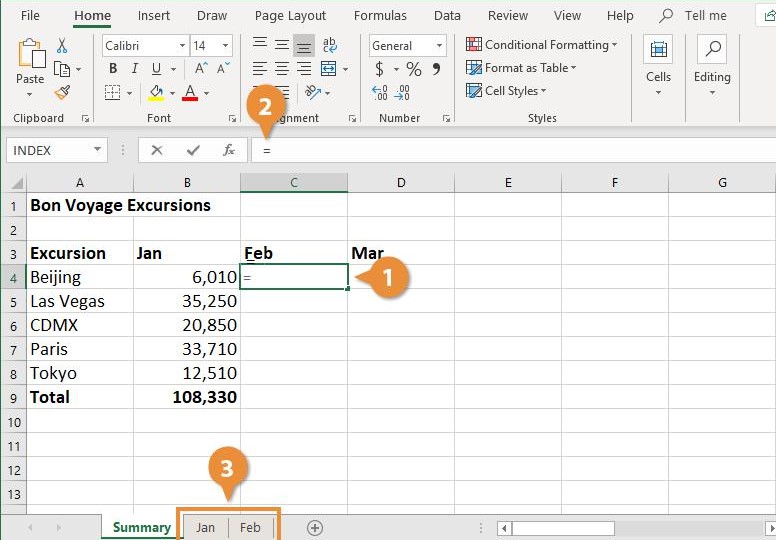Sum Excel Column from Another Sheet Easily

The ability to compile and analyze data across multiple sheets in Excel is a crucial skill for anyone dealing with complex datasets. Whether you're a business analyst, accountant, or data enthusiast, knowing how to sum data from one sheet to another can streamline your work significantly. In this post, we will explore various methods to sum Excel columns from another sheet easily, optimizing your workflow and enhancing your Excel proficiency.
Understanding the Basics of Excel Sheet References

Before diving into summing columns, it’s crucial to grasp how Excel references cells from other sheets:
- Absolute References: These remain constant no matter where the formula is copied. They are denoted by dollar signs (e.g.,
$A$1). - Relative References: These change when the formula is copied to another cell (e.g.,
A1). - Sheet References: When referencing another sheet, you include the sheet name followed by an exclamation mark (e.g.,
Sheet2!A1).
🔑 Note: Understanding these types of references is key to using Excel's powerful data manipulation capabilities effectively.
Summing Columns from Another Sheet - Basic Approach

The simplest way to sum columns from another sheet involves using Excel's SUM function:
=SUM(Sheet2!A:A)Here's how to apply this:
- Navigate to the cell where you want the total to appear on your current sheet.
- Enter the SUM formula referencing the column on the other sheet.
- Press Enter to display the result.

Summing with Dynamic References

If the data range in the other sheet changes often, or you want to reference only a part of the column:
=SUM(Sheet2!A1:A100)or for dynamic ranges:
=SUM(Sheet2!$A$1:INDIRECT("Sheet2!A" & COUNTA(Sheet2!A:A)))This formula will sum from cell A1 to the last non-empty cell in column A.
| Formula | Description |
|---|---|
Sheet2!A1:A100 |
Sums a specific range within the column. |
Sheet2!$A$1:INDIRECT("Sheet2!A" & COUNTA(Sheet2!A:A)) |
Automatically adjusts the range to the last non-empty cell. |

Using 3D References for Summing

For summing columns across multiple sheets:
=SUM(Sheet1:Sheet3!A:A)This formula sums column A from Sheet1 through Sheet3. This is particularly useful when dealing with uniform data structures across sheets.
Advanced Techniques: SUMIF and SUMIFS

Sometimes you only want to sum values that meet specific criteria:
=SUMIF(Sheet2!B:B, "Criterion", Sheet2!A:A)For multiple criteria:
=SUMIFS(Sheet2!A:A, Sheet2!B:B, "Criterion1", Sheet2!C:C, "Criterion2")
These formulas are especially handy in scenarios where you're dealing with extensive datasets where not all entries need to be summed.
Automating with Macros

For users comfortable with VBA:
- Open the VBA editor (Alt + F11).
- Create a new module (Insert > Module).
- Write your VBA code to automate the summing process.
Example VBA code for summing and writing to another sheet:
Sub SumAcrossSheets()
Dim ws As Worksheet
Dim lastRow As Long
Dim total As Double
' Assume sheet names are "Sheet1" to "Sheet3" for data, and "Summary" for results
For Each ws In ThisWorkbook.Worksheets
If ws.Name Like "Sheet[1-3]" Then
lastRow = ws.Cells(ws.Rows.Count, "A").End(xlUp).Row
total = total + WorksheetFunction.Sum(ws.Range("A2:A" & lastRow))
End If
Next ws
ThisWorkbook.Worksheets("Summary").Range("B2").Value = total
End Sub
Remember to run this macro after setting up your data in the sheets mentioned.
Recap and Moving Forward

Throughout this guide, we’ve delved into several methods for summing columns from another sheet in Excel, ranging from basic SUM formulas to advanced VBA automation. Each technique offers its own set of benefits:
- Basic SUM formulas for straightforward summation.
- Dynamic references for adaptable data ranges.
- 3D references for summing across multiple sheets.
- SUMIF/SUMIFS for conditional summation.
- VBA macros for complex and repetitive tasks.
As you incorporate these methods into your Excel workflow, you'll not only enhance your data analysis capabilities but also save valuable time. Excel’s versatility in managing and analyzing data across sheets is a testament to its power as a tool for professionals in any field that relies on data.
Remember, the key to mastering Excel lies in continuous learning and practice. Don't be afraid to experiment with different approaches to find what works best for your specific needs. Excel continues to evolve, with new features like dynamic arrays and Power Query enhancing its capabilities even further. Stay updated with Excel's developments, and your proficiency with this tool will undoubtedly grow, making you indispensable in any data-driven environment.
What is the difference between SUM and SUMIF?

+
SUM simply adds up all the numbers in a range. SUMIF, however, allows you to sum only the cells that meet certain criteria. For example, you might want to sum only the sales made by a specific salesperson.
Can I sum columns from multiple sheets without VBA?

+
Yes, you can use 3D references to sum columns from multiple sheets without writing any VBA code. The formula =SUM(Sheet1:Sheet3!A:A) sums column A from Sheet1 through Sheet3.
What should I do if my data range in the other sheet changes often?

+
Utilize dynamic references. For instance, the formula =SUM(Sheet2!A1:INDIRECT(“Sheet2!A” & COUNTA(Sheet2!A:A))) will sum from A1 to the last non-empty cell in column A, adjusting automatically as your data grows or shrinks.



